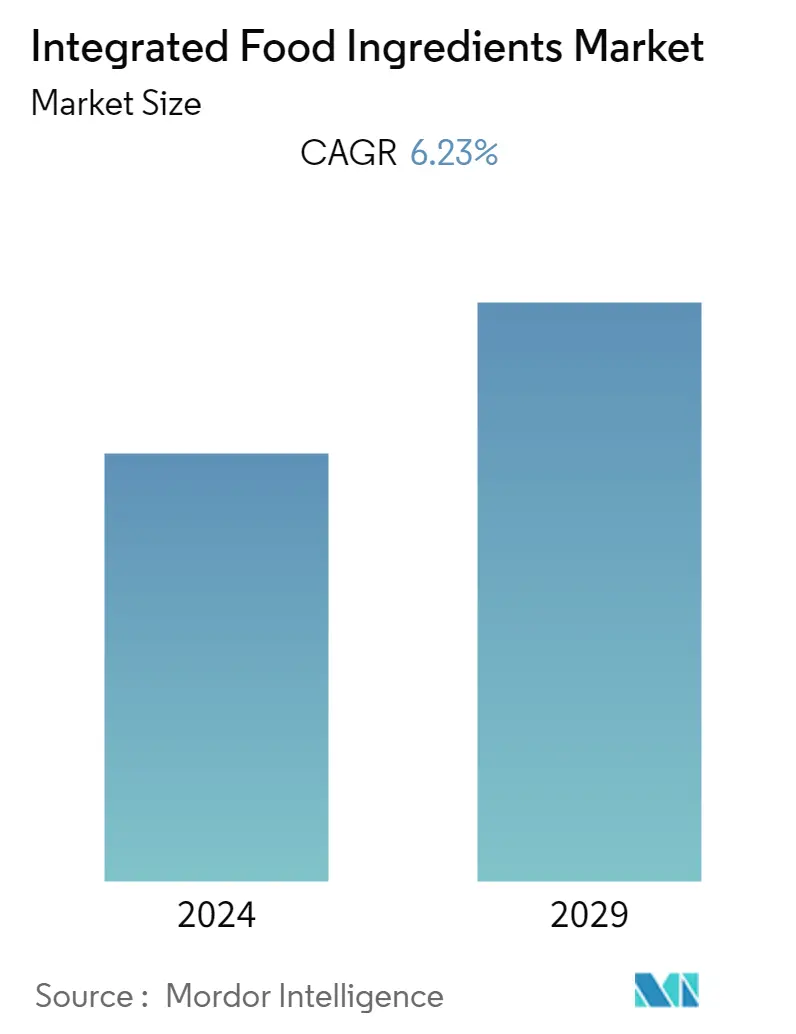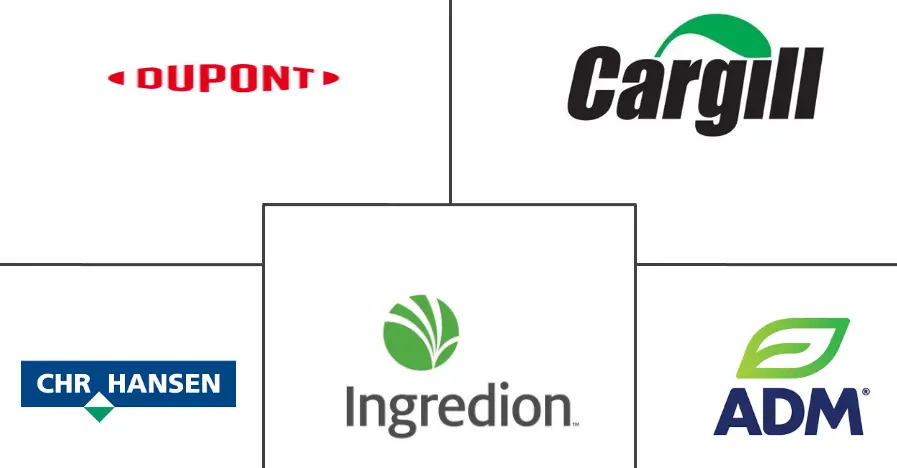Market Size of Integrated Food Ingredients Industry

| Study Period | 2019 - 2029 |
| Base Year For Estimation | 2023 |
| CAGR | 6.23 % |
| Fastest Growing Market | Asia Pacific |
| Largest Market | Europe |
| Market Concentration | High |
Major Players
*Disclaimer: Major Players sorted in no particular order |
Integrated Food Ingredients Market Analysis
The integrated food ingredients market is projected to grow at a CAGR of 6.23% during the forecast period (2020-2025).
The industry for integrated food ingredients essentially thrives on the wider technological and functional benefits that these ingredients confer, in terms of high quality, safety, affordability, nutrition, and deliciousness of the processed food products. The preference for certain types of food products is now core to some consumers' identities, especially in developed economies, which is driving the demand of speciality food ingredients.
The global marketplace have witnessed significant growth in plant-based ingredients. Companies are seeking to infuse and incorporate the active principles of botanical in a wide variety of non-alcoholic beverages. Companies, such as ADM, Givaudan, Symrise, are increasingly seeking to cater to the robust demands of fruit-containing flavor systems for the beverage industry in Europe.
Integrated Food Ingredients Industry Segmentation
The Integrated food ingredients market is segmented by type as Concentrates (Juice & Milk), Sweeteners, Flavors, Colors, Preservatives, Emulsifiers, Acidulants, Fats & Oils, and Starch, by application as Beverages, Snacks & Savories, Dairy Products, Meat Products and Bakery & Confectionery and by Geography.
| By Type | |
| Concentrates (Juice & Milk) | |
| Sweeteners | |
| Flavors | |
| Colors | |
| Preservatives | |
| Emulsifiers | |
| Acidulants | |
| Fats & Oils | |
| Starch |
| By Application | |
| Beverages | |
| Snacks & Savories | |
| Dairy Products | |
| Meat Products | |
| Bakery & Confectionery |
| By Geography | ||||||||
| ||||||||
| ||||||||
| ||||||||
|
Integrated Food Ingredients Market Size Summary
The integrated food ingredients market is experiencing robust growth, driven by the technological and functional advantages these ingredients offer, such as enhanced quality, safety, affordability, and nutrition in processed foods. This market is closely linked to the processed food sector, providing customized value additions based on end-user applications. The demand for specialty food ingredients is particularly strong in developed economies, where consumer preferences for specific food products are becoming integral to their identities. The market is also witnessing a significant rise in plant-based ingredients, with companies like ADM, Givaudan, and Symrise focusing on botanical infusions in non-alcoholic beverages, especially in Europe. This trend is fueled by consumers' increasing awareness of nutrition profiles and label claims, as well as their proactive approach to health and fitness, which has led to a higher consumption of probiotic and specialty ingredient-infused products.
As the global food economy evolves, there is a growing demand for food products that offer additional nutritional value, with a preference for cleaner and more natural ingredients. This shift is prompting food manufacturers to develop products with minimal processing and natural components. In regions like Latin America and Europe, consumers are particularly concerned about the long-term effects of their food choices, increasing the pressure on suppliers of natural key ingredients. Major industry players, including Archer Daniels Midland, KONINKLIJKE DSM NV, Ingredion Incorporated, and Cargill Inc., are responding to these consumer demands through product innovations, mergers, acquisitions, and partnerships. Cargill Inc., a market leader, has been particularly active in introducing premium culinary solutions for bakery manufacturers, highlighting the industry's focus on meeting evolving consumer needs and preferences.
Integrated Food Ingredients Market Size - Table of Contents
-
1. MARKET DYNAMICS
-
1.1 Market Drivers
-
1.2 Market Restraints
-
1.3 Opportunities
-
1.4 Porters 5 Force Analysis
-
1.4.1 Threat of New Entrants
-
1.4.2 Bargaining Power of Buyers/Consumers
-
1.4.3 Bargaining Power of Suppliers
-
1.4.4 Threat of Substitute Products
-
1.4.5 Intensity of Competitive Rivalry
-
-
-
2. MARKET SEGMENTATION
-
2.1 By Type
-
2.1.1 Concentrates (Juice & Milk)
-
2.1.2 Sweeteners
-
2.1.3 Flavors
-
2.1.4 Colors
-
2.1.5 Preservatives
-
2.1.6 Emulsifiers
-
2.1.7 Acidulants
-
2.1.8 Fats & Oils
-
2.1.9 Starch
-
-
2.2 By Application
-
2.2.1 Beverages
-
2.2.2 Snacks & Savories
-
2.2.3 Dairy Products
-
2.2.4 Meat Products
-
2.2.5 Bakery & Confectionery
-
-
2.3 By Geography
-
2.3.1 North America
-
2.3.1.1 United States
-
2.3.1.2 Canada
-
2.3.1.3 Mexico
-
2.3.1.4 Rest of North America
-
-
2.3.2 Europe
-
2.3.2.1 Spain
-
2.3.2.2 United Kingdom
-
2.3.2.3 Germany
-
2.3.2.4 France
-
2.3.2.5 Italy
-
2.3.2.6 Rest of Europe
-
-
2.3.3 Asia Pacific
-
2.3.3.1 China
-
2.3.3.2 Japan
-
2.3.3.3 India
-
2.3.3.4 Australia
-
2.3.3.5 Rest of Asia-Pacific
-
-
2.3.4 Rest of the World
-
2.3.4.1 Africa
-
2.3.4.2 Middle East
-
2.3.4.3 South America
-
-
-
Integrated Food Ingredients Market Size FAQs
What is the current Integrated Food Ingredients Market size?
The Integrated Food Ingredients Market is projected to register a CAGR of 6.23% during the forecast period (2024-2029)
Who are the key players in Integrated Food Ingredients Market?
Cargill Inc, Koninklijke DSM N.V., Ingredion Incorporated, ADM and Dupont are the major companies operating in the Integrated Food Ingredients Market.

